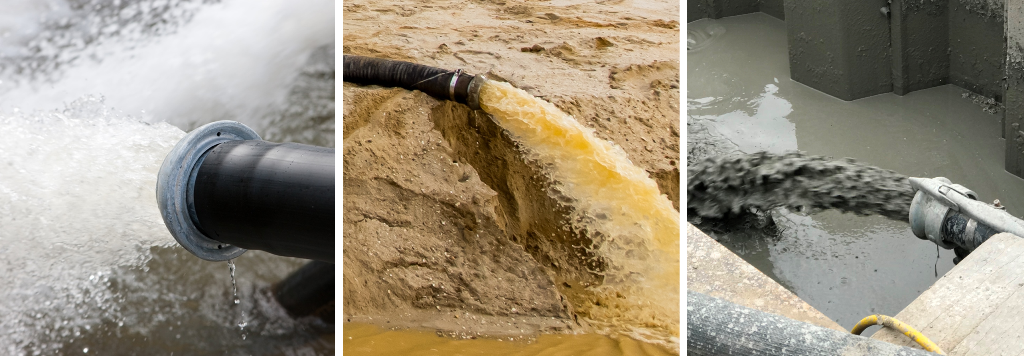Fluids and hydraulics
BBA Pumps has compiled a list of common liquids that we regularly pump. Which liquid are you going to pump? Which pump type is the best choice for that liquid? Our list of commonly pumped liquids has been carefully compiled and provides answers to frequently asked questions. If your liquid is not listed, please contact us for customized pump advice.
Fluids
Fluids and pumping fluids include both liquids and gases (e.g., air or water vapor). When we define pumping fluids, we limit ourselves mainly to water, with solids and contaminants that are present in it to a larger or lesser degree. We look at the properties of water and describe the various liquid contaminants.
Pumping fluids
Clear Water
By clear water we do not necessarily mean pH neutral drinking water. Examples of clear water include: groundwater, rainwater and also purified wastewater. Pumps always have a small free passage, so if some dirt particles are present in clear water, this is not directly harmful to the pump.
All BA series, PT series and B series models are suitable for pumping clean water.
Dirty Water
Dirty water is a commonly used and broad term. When we define dirty water we refer to pH neutral water containing a percentage of fine or coarse solids. The successful pumping of dirty water requires the pump to have a large free passage. Standard centrifugal pumps can easily pump up to 5% solids. More wear-resistant dirty water pumps can even handle up to 10% pollution. Examples of dirty water include: flood water, muddy water, domestic and unfiltered wastewater. It is recommended to use a centrifugal pump with a (semi) open pump impeller in combination with a wear plate.
The percentages quoted are a mixing ratio based on the weight of the liquid. Popular models for the pumping of dirty water include the BA75, BA100E and BA150E.
Raw Sewage Water
Untreated raw sewage is a liquid mixture with coarse dirt particles, long-fibrous materials and may often contain low levels of chemical or abrasive pollution. Untreated sewage, for example, also contains; oils, fats, organic materials and heavy metals collected as a run-off from streets. When pumping sewage, use specialist pumps, preferably with a screw channel impeller and cutting grooves.
Popular pump models for handling raw sewage water include the BA100K, BA150KS and BA180KS.
Wastewater
Wastewater is a commonly used term and is often synonymous for sewage. Other forms of wastewater are; industrial wastewater, domestic wastewater and storm water. In many cases, a dirty water pump or a sewage pump is sufficient for pumping wastewater.
There are many models from the BA series and B series which are well suited for pumping wastewater. Contact us for customized advice.
Contaminated Water or Polluted Water
By contaminated or polluted water we refer to a liquid with multiple contaminants from a wide variety of harmful substances. Think of chemicals, micro-organisms, sediments, cleaning agents and pesticides. In order to pump contaminated water, it is important to use suitable materials (for example cast iron or stainless steel pumps).
Many BA series and B series pumps are suitable for pumping contaminated and polluted water. Contact us for specialized pump advice.
Abrasive Water
Abrasive water contains abrasive particles that cause more than average wear on the pump parts. This includes sand, silt or bentonite. If the percentage of such solids is high, then we recommend the use of a wear-resistant pump, possibly treated with a wear-resistant coating.
The models from the BV series are well suited for pumping bentonite. For liquids with high levels of abrasive particles please contact us for specialized pump advice.
Liquid manure
Liquid manure refers to slurry water consisting of animal waste and organic matter. It can be cow manure or pig manure and is stored in slurry pits. In liquid manure we frequently see remnants of hay and straw. Slurry is used to make the soil fertile and therefore often needs to be pumped. A mixer ensures that the manure is thin enough to be pumped with a centrifugal pump. For draining slurry pits, the self-priming B70-4 wheelbarrow pump is popular. And for the drag hose application, where the slurry is spread on the land, a BA110H high head pump is the best solution. Contact us for more pump information.
Which pump or impeller type is the best choice?
In general terms, the free passage of the pump determines the maximum size of coarse particles that the pump can handle. The type of pump impeller is also an important factor. The most common impeller types of BBA Pumps are listed below, with a clear explanation of which fluid they are best suited for.
E-impeller
The E-impeller is a semi-open impeller with a large free passage, it is well suited for pumping dirty water and sewage without long fibrous materials.
G-impeller
The G-impeller is an axial flow impeller with a large free passage for pumping high volumes of dirty water.
H-impeller
The H-impeller is a closed impeller with a small free passage for pumping both clear water and slightly contaminated water.
K-impeller
The K-impeller is a channel impeller with a large free passage for pumping dirty water and sewage water.
KS-impeller
The KS-impeller is a screw channel impeller with a large free passage for pumping raw sewage with long fibrous materials.
And for the pump professionals…
Hydraulics
Hydraulics is the behavior of fluids at rest or in motion. Hydraulics is part of fluid mechanics; we focus mainly on the properties of water. Pumps transport liquids, creating a flow in pipes. This is an area of hydraulics in which we have a deep understanding and experience. We would be delighted to share our expertise with you.Viscosity
Viscosity is the degree of fluidity of a liquid and thus indicates its viscosity. The viscosity of a liquid depends on the temperature: at higher temperatures many liquids are less viscous than at lower temperatures. We distinguish;- Kinematic viscosity, for determining resistance losses in pipes, expressed in centistokes (cSt).
- Dynamic viscosity is the resistance a fluid offers to a shearing force under the influence of moving objects, expressed in pascal seconds (Pa s) or centipoise (cP).





